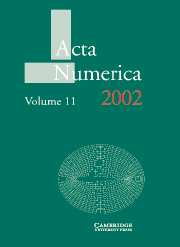Book contents
- Frontmatter
- Contents
- 1 Structured inverse eigenvalue problems
- 2 Subdivision schemes in geometric modelling
- 3 Adjoint methods for PDEs: a posteriori error analysis and postprocessing by duality
- 4 Finite elements in computational electromagnetism
- 5 Splitting methods
- 6 Topological techniques for efficient rigorous computation in dynamics
- 7 The immersed boundary method
- 8 Numerical methods for large eigenvalue problems
4 - Finite elements in computational electromagnetism
Published online by Cambridge University Press: 21 May 2010
- Frontmatter
- Contents
- 1 Structured inverse eigenvalue problems
- 2 Subdivision schemes in geometric modelling
- 3 Adjoint methods for PDEs: a posteriori error analysis and postprocessing by duality
- 4 Finite elements in computational electromagnetism
- 5 Splitting methods
- 6 Topological techniques for efficient rigorous computation in dynamics
- 7 The immersed boundary method
- 8 Numerical methods for large eigenvalue problems
Summary
This article discusses finite element Galerkin schemes for a number of linear model problems in electromagnetism. The finite element schemes are introduced as discrete differential forms, matching the coordinate-independent statement of Maxwell's equations in the calculus of differential forms. The asymptotic convergence of discrete solutions is investigated theoretically. As discrete differential forms represent a genuine generalization of conventional Lagrangian finite elements, the analysis is based upon a judicious adaptation of established techniques in the theory of finite elements. Risks and difficulties haunting finite element schemes that do not fit the framework of discrete differential forms are highlighted.
Introduction
Most modern technology is inconceivable without harnessing electromagnetic phenomena. Hence the design and analysis of schemes for the approximate solution of electromagnetic field problems can claim a rightful place as a core discipline of numerical mathematics and scientific computing. However, for a long time it received far less attention among numerical analysts than, for instance, computational fluid dynamics and solid mechanics.
One reason might be that electromagnetism is described by a generically linear theory, in the sense that linear equations arise from basic physical principles. This is in stark contrast to continuum mechanics, where linear models only emerge through linearization of inherently nonlinear governing principles. Being linear, the fundamental laws of electromagnetism might have struck many mathematicians as ‘dull’. This view might also have been fostered by the misconception that electromagnetism basically boils down to plain second-order elliptic equations, which have been amply studied and are well understood.
- Type
- Chapter
- Information
- Acta Numerica 2002 , pp. 237 - 340Publisher: Cambridge University PressPrint publication year: 2002
- 25
- Cited by

